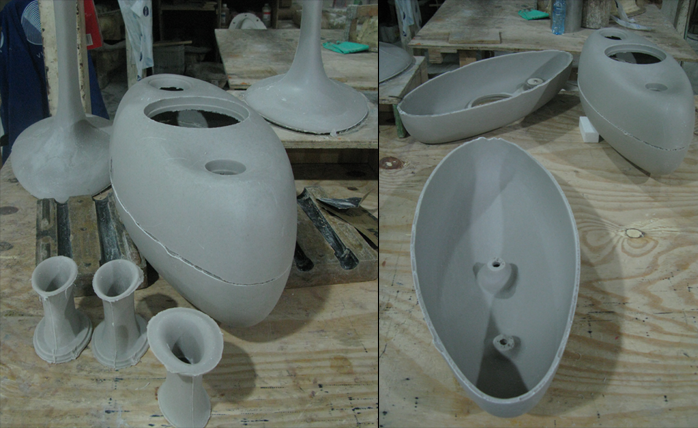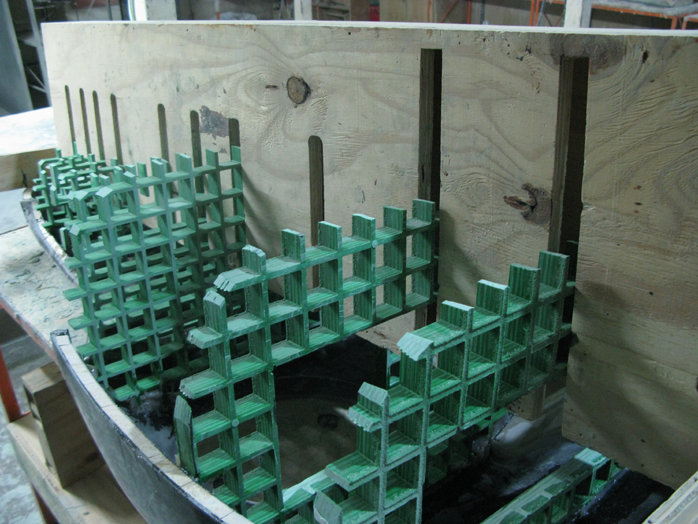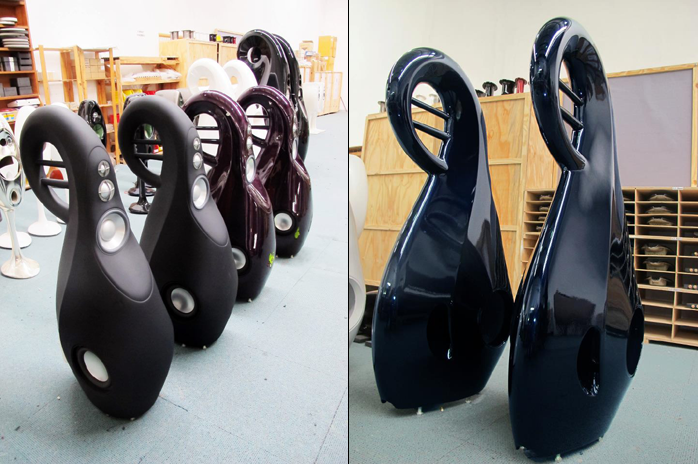This review page is supported in part by the sponsors whose ad banners are displayed below |
 |
 |
|
It's in their bass arrays where the Oval and Giya range differ radically. In most Vivid speakers the tubes for the tweeter, midrange and upper-bass drivers terminate within the cabinet and only the smaller G3 and G4 show them externally as was the case for the iconic B&W Nautilus. The Giya woofers are very specific to make use of the curl at the top of the cabinet which acts as a kind of inverted exponential rear horn. This tapered tube dedicated to the bass drivers works in conjunction with the cabinet's dual ports as an acoustic filter. Frequencies below 100Hz remain within the lower chamber where the ports do their job whilst the tapered tube dissipates frequencies above 100Hz. The Giya ports are designed to cancel their reactive forces against each other. These features again highlight the cabinet shape's vital influence on the overall sonic outcome.
|
 |
Original shapes.
|
Coming back to upper drivers, the D26 dome tweeter's first break-up mode doesn't occur until 44kHz. The radially polarized magnet system is made up of eight high-power Neodymium iron boron magnets to maximize voice-coil flux with an intrinsically low stray field. The edge-wound aluminum voice coil ensures the best match between aluminum diaphragm and gap flux. Silicon O-rings decouple the D26 and D50 from the enclosure.
The D50 midrange shares the same design and covers 880Hz to 4kHz. The D50 maintains its pistonic behavior for more than two octaves beyond its operating band where first breakup doesn't occur until 20kHz. Thanks to its radial magnet structure the D50 can be used in a narrow enclosure with minimum distance from other drivers. The underhung edge-wound aluminum voice coil makes for an efficient impedance match. The use of radial magnets is due to Vivid’s tapered tube-loading of its dome drivers which thus rely on the largest possible central pole hole to flow their rear energies freely into the absorber. That requirement excluded the use of round disc magnets mounted within the voice coil. As the dome drivers sit very close together for optimal smooth vertical dispersion, it became quite challenging to have two external ring magnet arrays in close proximity. Here a rear-mounted radial magnet became the best solution which also allows a higher maximum gap flux than conventional flat rings and thus higher efficiency.
|
|
|
|
Vivid's driver baskets are made from pressure-cast aluminum. Twelve supporting struts exhibit an unusually narrow aspect ratio for minimum obstruction. Ideally there should be nothing behind the cone which might cause resonance, reflection or any other perturbation of the sound coming off the diaphragm's rear. The 3mm wide struts of the K1’s C125 drivers represent just 10% of the cone area to effectively render them acoustically invisible. The compact rare-earth radial magnet assembly complements this chassis with its small frontal area. The vented ports of the Oval line eliminate potential cabinet resonances by being horizontally opposed.
|
 |
The Giya models adopt a more sophisticated shape whose narrowness enforced their sidefiring woofers. Placing identical drivers on opposite sides of the enclosure whilst their magnets are rigidly coupled cancels out reactive forces to ensure that no vibrational energies transmit to the enclosure as long as both drivers process the same signal. Should a differential force appear, elastomeric O-rings under each driver rim control such asymmetries.
|
 |
The K1s specs are 89dB@2.83Vrms/1m sensitivity, 6-ohm nominal impedance (4.8Ω min.), 33-36'000Hz response -6dB (38-33'000Hz +/-2dB on reference axis), 2nd/3rd-order THD below 0.5% full bandwidth and power handling of 600Wrms.
|
|
|
Since all Vivid speakers share the same more or less sophisticated driver, enclosure and filter technologies, they are among the most neutral speakers I know. Their particular design nonetheless leads to certain idiosyncrasies how they represent sound. Their three-dimensionality, dark background and air make me think about electrostatic speakers. These Laurence Dickie creations in my opinion are the closest to electrostatic sound we'll find among various electrodynamic designs yet drums and bass have more weight, impact and authority than electrostats can delivers. Dynamics and transient speed are amongst the best I know in fact.
|
 |
My K1's effortless transparency allows it to disappear completely as an apparent acoustic source. Acoustic phase consistency is impressive and the resultant soundstage is wide and deep with precise layering. The K1 provides plenty of fine detail not presented clinically which seeming emerges from nowhere as though instruments teleported themselves directly around the speakers. The result is a heightened sense of immediacy and realism. Another striking feature of my Vivid speakers is their agility. Their transparency combined with an incredible sense of speed transcends the struggle between melodic and percussive aspects whilst honoring tonal richness. It's particularly obvious on piano recordings where the speakers highlight all their tonal and dynamic complexity. These Vivid floorstanders are able to express the finest most subtle sympathetic harmonics as well as the most violent fortissimos. Even during the most intense passages the sound never gets in your face but remains under complete control. Romantic piano music thus becomes a pure delight over these South African speakers.
|
 |
  |
 |